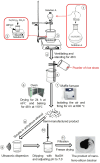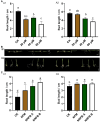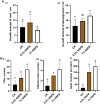New nano-ferro-silicon biochar promotes plant growth and grain yield under arsenic stress in rice
- PMID: 40385235
- PMCID: PMC12081388
- DOI: 10.3389/fpls.2025.1556696
New nano-ferro-silicon biochar promotes plant growth and grain yield under arsenic stress in rice
Abstract
Arsenic (As) is a ubiquitous and toxic metalloid in nature, posing significant risks to living organisms. Developing sustainable strategies to mitigate As stress and reduce As accumulation in rice is critical for ensuring food safety in contaminated regions. Herein, we synthesized a new nano-ferro-silicon biochar (NNFB) composed of biochar, γ-Fe2O3, and SiO2, which effectively adsorbed As from aqueous solutions and soil. NNFB alleviated As toxicity by promoting rice seeding and root growth at the seed germination and seeding stages. Under 40 μM As(III) treatment, application of 0.25% and 0.5% NNFB regulated the reactive oxygen species (ROS) balance by reducing H2O2 accumulation and enhancing peroxidase (POD) activity in leaves. Additionally, NNFB reduced As uptake by regulating the expression of As transport genes OsABCC1, OsLsi1, and OsLsi2 at the seeding stage. In pot experiments with 40 mg/kg As(III)-contaminated soil, NNFB application significantly improved aboveground biomass, tiller number, and effective tiller count. Notably, seed number per plant increased by 6.93- and 7.93-fold in 0.5% and 1% NNFB treatments compared to the control. These findings demonstrate that NNFB efficiently adsorbs As, mitigates As stress at multiple growth stages, and enhances rice productivity, offering a promising solution for As-contaminated agricultural systems.
Keywords: arsenic stress alleviation; grain yield; new nano-ferro-silicon biochar; plant growth promotion; rice.
Copyright © 2025 Fang, Dong, Ye, Zhang and Liu.
Conflict of interest statement
The authors declare that the research was conducted in the absence of any commercial or financial relationships that could be construed as a potential conflict of interest.
Figures







Similar articles
-
Editing Silicon Transporter Genes to Reduce Arsenic Accumulation in Rice.Environ Sci Technol. 2024 Jan 30;58(4):1976-1985. doi: 10.1021/acs.est.3c10763. Epub 2024 Jan 17. Environ Sci Technol. 2024. PMID: 38232111
-
Impacts of biochar and silicate fertilizer on arsenic accumulation in rice (Oryza sativa L.).Ecotoxicol Environ Saf. 2020 Feb;189:109928. doi: 10.1016/j.ecoenv.2019.109928. Epub 2019 Nov 22. Ecotoxicol Environ Saf. 2020. PMID: 31767458
-
Optimizing biochar, vermicompost, and duckweed amendments to mitigate arsenic uptake and accumulation in rice (Oryza sativa L.) cultivated on arsenic-contaminated soil.BMC Plant Biol. 2024 Jun 13;24(1):545. doi: 10.1186/s12870-024-05219-w. BMC Plant Biol. 2024. PMID: 38872089 Free PMC article.
-
Cadmium stress in rice: toxic effects, tolerance mechanisms, and management: a critical review.Environ Sci Pollut Res Int. 2016 Sep;23(18):17859-79. doi: 10.1007/s11356-016-6436-4. Epub 2016 Mar 21. Environ Sci Pollut Res Int. 2016. PMID: 26996904 Review.
-
Arsenic uptake, accumulation and toxicity in rice plants: Possible remedies for its detoxification: A review.Environ Sci Pollut Res Int. 2017 Apr;24(10):9142-9158. doi: 10.1007/s11356-017-8462-2. Epub 2017 Feb 3. Environ Sci Pollut Res Int. 2017. PMID: 28160172 Review.
References
-
- Chandrakar V., Naithani S. C., Keshavkant S. (2016). Arsenic-induced metabolic disturbances and their mitigation mechanisms in crop plants. Biol. 71, 367–377. doi: 10.1515/biolog-2016-0052 - DOI
-
- Chatterjee A., Mridha D., Banerjee J., Chanda S., Ray K., Acharya K., et al. . (2021). Green synthesis of iron oxide nanoparticles and their ameliorative effect on arsenic stress relief in Oryza sativa seedlings. Biocatal. Agric. Biotechnol. 38, 102207. doi: 10.1016/j.bcab.2021.102207 - DOI
LinkOut - more resources
Full Text Sources
Research Materials

